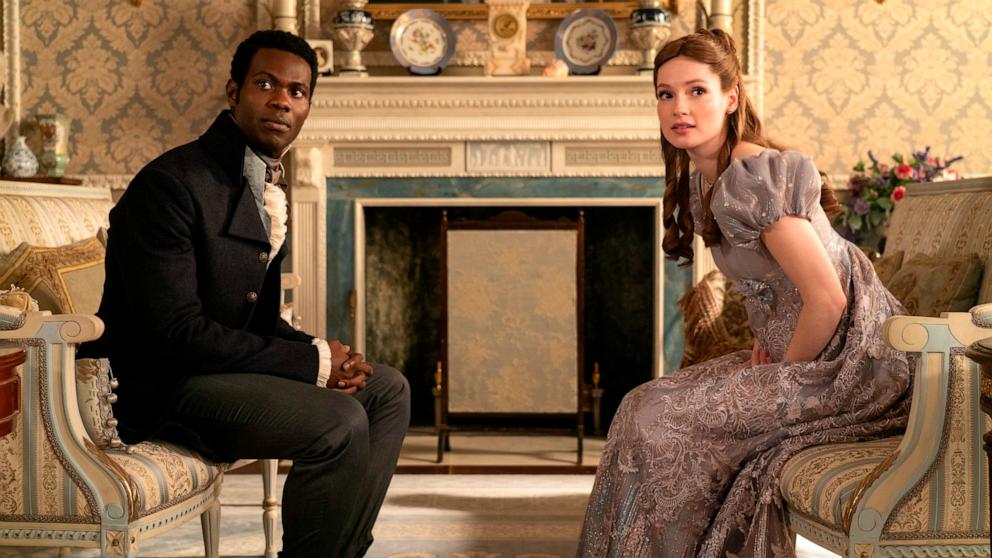WATCH: Nicola Coughlan and Luke Newton talk about ‘Bridgerton’
“Bridgerton” showrunner Jess Brownell says she and her team were “very conscious” about inclusivity when they began production on Season 3 of the hit Netflix and Shondaland show.
For that very reason, disability representation played a larger, more commendable role this season.
“This show, in particular, has a reputation for being very inclusive, so we want to continue to expand that reputation so that more people can see representation in their world,” Brownell said in an interview on “Good Morning America.”
Viewers may have noticed that Lord Remington, played by disabled actor Zach Ford-Williams, uses a historically accurate wheelchair in the show. “The wheelchair that you see is a recreation of what a wheelchair would have looked like back in the day,” Brownell said.
Or maybe they noticed that Miss Dolores Stowell, played by Kitty Devlin, uses British Sign Language to communicate with her mother.
Brownell said making the sign language historically accurate is an even bigger challenge: According to University College London, there was no standardized sign language in Britain in the early 1800s.
Instead, the family uses a domestic sign language, which was created by the family members themselves and passed down through generations, Brownell added.
“Bridgerton” writers instead opted for modern British Sign Language so audiences could “see themselves represented in a way they could relate to”, Brownell added.
Raym Daniel/Netflix
The “Bridgerton” episode features Victor Ali as John Sterling and Hannah Dodd as Francesca Bridgerton.
Some viewers have speculated that Francesca Bridgerton and her lover Lord Kilmartin have neurodevelopmental disorders, a question Brownell says the writers asked themselves in the writing room.
Brownell said the film is a fairly accurate adaptation of author Julia Quinn’s novel series, which features a character with a deep love of music, an introvert and someone overwhelmed by the chaos of the Bridgerton household.
“To be honest with you, when we first started creating her character in the room, we didn’t set out to create a neurodevelopmental character or even to diagnose her,” Brownell said.
Liam Daniel/Netflix
Hannah Dodd, who plays Francesca Bridgerton, will appear in the episode “Bridgertons.”
Nicola Coughlan and Luke Newton talk about Bridgerton season 3’s friends-turned-lovers romance
She continued, “But as we dug deeper into her character, everyone in the room thought, ‘This certainly seems like a neurodiverse trait.'”
Brownell and his team questioned whether Quinn intended to write a character that could be interpreted as having a neurodevelopmental disorder.
“I think the fact that people see themselves in her and identify as someone with a neurodevelopmental disorder is a wonderful thing,” she said.
Liam Daniel/Netflix
The “Bridgerton” episode will feature Adwoa Andoh as Lady Agatha Danbury and Daniel Francis as Lord Anderson.
The world of “Bridgerton” has regularly tackled the representation of disability, from Lady Danbury’s use of a cane to King George’s experiences with mental illness.
But the show goes beyond on-screen representation of people with disabilities: it also ensures the accessibility of the show itself by providing open audio description and open captioning available in 14 languages.
One of the show’s lead producers, Sarah Fisher, is also co-founder of the 1in4 Coalition, which, according to its website, is “a multidisciplinary coalition of creative people with disabilities” who help ensure that the representation of disability in media is honest and accurate.
According to the CDC, one in four U.S. adults has some kind of disability, roughly 27% of the population. But statistics show that fewer than 1% of people with disabilities are visible on screen, according to 2022 data from research group Nielsen.
Brownell said the team worked with consultants from the 1in4 Coalition to create the new characters.
Isabel Infantes/Reuters
Hannah Dodd arrives at the Bridgerton Season 3 Part 2 launch event in London on June 12, 2024.
“I remember the first time I went to a fan screening, I don’t know if there were any deaf people in the audience, but their reaction to seeing Stowell and her mom sign was audible,” Brownell said. “And I want every audience member to feel that way. Seeing ourselves on screen is so important. Television is our gateway to believing in a bigger life and imagining what’s possible, so it’s really, really encouraging to see that.”
In an Instagram post in May, shortly after Season 3 premiered, the 1in4 Coalition praised the Bridgerton team for their efforts to make the show and its setting more inclusive.
“Thank you to the Shondaland team, including 1IN4 co-founder Sarah Fisher, for including disability representation in the series and making the set accessible!” the group wrote.
New trailer for Bridgerton Season 3 Part 2: Watch it here
Brownell said the Bridgerton team plans to broaden the show’s scope in the future to include gay and disabled characters.
“I want to do that in a bigger way, not just as a side story,” Brownell said. “I think it’s really important for people to see themselves represented, and especially in a show that’s about the different ways people can love, I think it makes sense to include gay love.”

